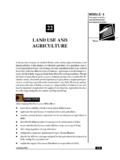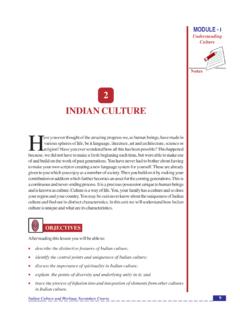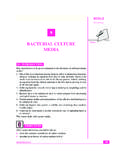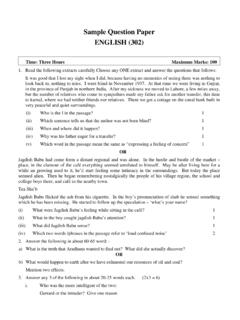Transcription of 11 F ABRIC FINISHES
1 MODULE - 1 Home Science in Daily Life 189 Fabric FinishesHOME SCIENCEN otes11 FABRIC FINISHESM arie-Ann and some of her friends had joined a hobby class to learn fabric evaluating individual articles, they noticed that the colours of some of the articleswere not uniform despite the fact the same colour had been used to paint all of they asked the instructor about it, they were told that the cotton fabrics withuneven colour-spread had been given some finish which needed to be washed beforeusing fabric painting colours. What does this mean? Do colours behave differently ondifferent types of materials? You have learnt about starching and heard terms like dyeing,printing, mercerization, etc. What are these processes and how do these influence thefunctions of fabric? In this lesson we will try to answer these and many similar studying this lesson you will be able to do the following: explain the meaning and importance of FINISHES given to fabrics; classify various FINISHES according to their properties; describe the effect of the application of basic FINISHES on fabrics; enumerate special FINISHES and explain the ways of employing them; elaborate the methods of dyeing and printing; evaluate different techniques of decorative dyeing and block printing on TEXTILE FINISHESYou know that the word textile means the complete study of fibres, yarns and treatments are applied to improve the look and qualities of textile goods.
2 Thesetreatments are called FINISHES . A finish is a treatment given to a fabric, to changeits appearance, handling /touch or performance. Its purpose is to make thefabric more suitable for its end SCIENCEMODULE - 1 Fabric FinishesHome Science in Daily Life 190 NotesA series of treatments are given in mills to finish textiles goods, for example: a fabric iswashed, bleached, dyed or printed, starched and ironed before it is sent to the a fabric is given a finish, it is known as a finished textile. But it is not a must thatall the textile-products are finished before use. When no finish is applied on the textiles,these are termed as gray goods or unfinished textiles. This does not mean that thefabric is gray in colour. It implies that no finishing treatment has been given to goods lack customer appeal and you will notlike to buy these for your dress or shirt. Can you saywhy? Yes, you are right.
3 It is because in the absenceof any finish, fabrics has dull and shabby colours or prints on fabrics are also finishesand these make fabrics look includes any general treatment given to clean and iron fabrics andcreate exclusive variations of them by using chemical treatments, dyeing,printing, etc. to make fabric attractive and major differences between Unfinished and finished fabrics are as follows:Unfinished / Gray fabricDull looking, available only in naturalcolours- off white, brown, black, , stained, with brokenthreads, uneven in width, less customer appeal, are purchasedonly for rough work, backing,packaging, Importance of Textile FinishesTextile FINISHES are important because of the following reasons. The FINISHES help to: improve the appearance of fabric and enhance its looks; produce variety in fabrics through dyeing and printing; improve the feel or touch of fabric;Gray goods are the termused for fabrics that comedirectly from the loom andare used as such.
4 These arenot actually gray in colourbut are unfinished .Finished fabricLusterous, attractive, available in differenttints and shades of colours, prints, and wrinkle-free, no defects on thesurface, even width, free from stains, of fabric depends upon the type of thefibre along with the number and type offinishes get attracted and - 1 Home Science in Daily Life 191 Fabric FinishesHOME SCIENCEN otes make the fabric more useful; improve the draping ability of light weight fabrics; make fabric suitable for an end (specific) CLASSIFICATION OF FINISHESF inishes can be classified in several ways depending upon their functions, performanceand and the basis of functionThe FINISHES may be basic or functionaliBasic or common FINISHES are applied to almost all the fabrics, with an aim toimprove their appearance, feel and body. Pale white cotton fabrics may be bleachedto improve their whiteness.
5 For better look of a thin cotton fabric, starch is appliedto increase its weight and shine. Steam Ironing, Calendaring (industrial ironing) isa basic finish. These are also known as aesthetic and printing are also considered as FINISHES as they enhance the aestheticappearance of or special FINISHES are applied to improve the performance of a fabricfor some specific purpose, for example- fireproof finish prevents the burning of fabrics used by fire brigade personnel, waterproof finish makes fabrics water repellent for making umbrellas andraincoats, bulletproof finish on fabric saves the people from bullets and is generally usedby defence and police personnel for their safety, and crease-resistant finish makes cotton / wool fabric wrinkle the basis of degree of performanceOn the basis of performance, FINISHES are temporary, semi durable, durable SCIENCEMODULE - 1 Fabric FinishesHome Science in Daily Life 192 NotesiTemporary FINISHES are not durable and run off after first washing or of these are renewable and can be reapplied at home.
6 Starching andblueing of white durable FINISHES stay on the fabric surface for several washings, bleachingand certain dyes used on FINISHES last through out the life of a fabric or a garment but may lose itseffectiveness after many washes, permanent pleats, wrinkle resistant, FINISHES are is usually given by a chemical treatment. It changes the fibrestructure and remains as such on the fabric for the entire life of a fabric, , fire proofing, and Mechanical FINISHES / Wet and dry finishesOn the basis of processes involved in application of finish, there are two types chemical(wet) and mechanical (dry) FINISHES : These are also known as wet FINISHES . In these, chemicaltreatment is given to fabric, either to change its appearance or basic FINISHES are usually durable and permanent or wet FINISHES . Examples are: fireproof, crease resistance, FINISHES : These are also known as dry FINISHES .
7 Here the processconsists of application of moisture, pressure and heat or a mechanical device tofinish a fabric. Beating, brushing, calendaring, filling, etc. are some of the finishesincluded in this group. These FINISHES are either temporary or semi durable and donot last will learn more about these FINISHES further in the QUESTIONS in the blanks after unscrambling the clues in the treatment given to fabrics to enhance their appearance, performance orhandling is known as _____ (N I F S I H E). no finish is applied on a fabric s surface, it is known as _____fabric (R A Y G). and _____ produce variety in fabric (Y ED I N G, N I N G P R I T). chemical finish is also known as _____ (E T W - I S H F I N). finish is a_____ finish. (N C F U T I O N A L).MODULE - 1 Home Science in Daily Life 193 Fabric FinishesHOME BASIC FINISHES AND THEIR TYPESNow that you know about different types of FINISHES , lets us learn a little more about basicfinishes.
8 Different types of basic FINISHES are (i)Scouring / CleaningFabric, as it comes from the loom, is dull in appearance. It may have stains of oils as wellas starches, waxes , etc., that are applied to yarns to make weaving easier. Once thefabric is woven, the presence of these additives hinders further finishing processes suchas bleaching, dyeing, printing, etc. Therefore, these need to be removed before sendingthe fabric for further processing. Scouring is the process of washing fabric with soapsolution. Scouring is the process of industrial cleaning of fabrics with the help ofwarm water and soap solution. It cleans the fabric and makes them moreabsorbent. The method of washing a fabric is chosen according to the nature of are boiled in soap solution for cleaning. Silks are boiled to remove silk gum(degumming) while the wool fibres are boiled with soap solution to remove grease andoils. Fabrics made from man-made fibres are given normal washing.
9 After cleaning, thefabric becomes smooth, neat and more out this experiment and note your observationsTake two fabric pieces of 4// x 4// size of white colour, one of theses should be new andthe other old and washed. Put both the pieces of fabric in water. What do you observe?The old one will sink faster because it is more absorbent as it has no FINISHES or starchon the surface. The new fabric will first float on the water. Gradually water penetratesthrough the starch applied on the fabric surface, and the fabric sinks.(ii)BleachingAt home you use lemon, milk, curd and facial bleach to remove sun-tan. A similartreatment is also given to fibres. Many a times natural fibres like cotton, silk and woolare available in pale / light brown colour. Suppose you have to paint some thing in lightpink colour, unfortunately the brush was not washed properly and had remains of brownin it. What do you think will happen?
10 You will not get the pink you wanted. This becomesa problem as light shades of dyes do not come out well on such fibre colours. To getexact light shade of the colour, the existing colour has to be removed. Bleaching is achemical treatment given to fibres, yarns or fabric to remove paleness or colourand make them white. Suitable bleaching agents such as hydrogen peroxide forprotein fibres and sodium hypochlorite for cottons, are used. Man-made fibres do notneed bleaching. Fabrics have to be carefully bleached as bleach can harm the fabric ifused in high SCIENCEMODULE - 1 Fabric FinishesHome Science in Daily Life 194 Notes(iii) Starching / StiffeningStarch is generally applied to fabric of fine quality and light weight or loosely wovenfibres. Starching makes the fabric heavier, stiff, and crisp. It also adds shine andsmoothness to the fabric. Cottons muslin, poplin, cambric and thin silks are the loosely woven cotton fabric is starched heavily so that their quality looksbetter but the starch comes out with the first wash and the basic loosely woven structureof the fabric becomes prominent.










